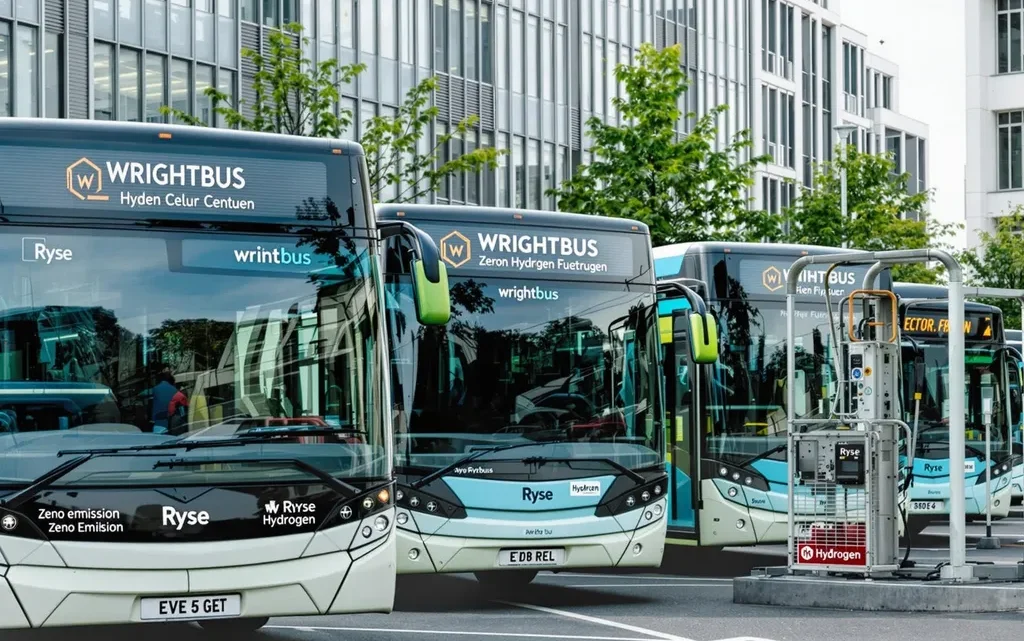
Hydrogen Fuel Cell Buses Take the Lead in UK Hydrogen Mega-Project Led by Wrightbus and Ryse Hydrogen
April 14, 2025Wrightbus, the zero-emission bus maker based in Northern Ireland, and its sister company Ryse Hydrogen have just stepped into the spotlight, taking the lead in a massive new UK initiative: a game-changing £6.5 billion hydrogen production and transport rollout unveiled in late 2024.
While the finer details are still unfolding, the goal is big and bold—build a full-blown green hydrogen ecosystem that doesn’t just produce hydrogen, but also gets it where it needs to go and puts it to work. And where better to start than with high-visibility, high-impact fuel cell buses?
This is more than just a public transport upgrade—it’s a shot across the bow of industrial decarbonization. It’s all about cleaning up the way we move, with hydrogen fuel cells at the heart of the mission. With both companies backed by UK clean energy investor Jo Bamford, they’re perfectly positioned to lead the nation’s next leap towards a clean transport infrastructure.
Project/Initiative Details
This project connects all the critical pieces. Ryse Hydrogen handles the green hydrogen production via electrolysis, while Wrightbus builds the buses that run on it. And because both companies are owned by Bamford, the whole thing operates as a single, streamlined system—everything from production to refueling to hitting the road.
Wrightbus, already known for its zero-emission Hydroliner buses running in cities like London and Birmingham, is gearing up to go even bigger under this new funding stream. We’re talking potentially thousands more buses rolling out in coming years to meet growing demand sparked by climate targets and net-zero policy pushes.
We haven’t been given the full list of cities yet, but given Wrightbus’s current partnerships with local transit agencies, we can expect early moves in places already chasing ambitious carbon goals.
Context and Background
The UK isn’t new to the hydrogen game. Over the last few years, it’s quietly become a serious player in the global hydrogen economy. Backed by government incentives and zero-emission vehicle schemes, the groundwork is already there.
Wrightbus has staked its future on hydrogen fuel cell technology as a scalable solution—especially for heavier-duty transport where batteries often fall short. And considering how close the company came to shutting its doors in 2019, its evolution under Bamford’s ownership is nothing short of impressive. It’s gone from near-collapse to being a cornerstone in the UK’s clean mobility comeback story.
This new £6.5 billion investment builds squarely on that momentum with a clear bet: hydrogen infrastructure is key to cleaning up sectors that are tough to electrify with batteries alone.
Parallel Examples
The UK isn’t going it alone. Around the world, we’re seeing similar blueprints in action. In Germany, the H2 Mobility initiative is pairing up hydrogen production with dedicated refueling stations and vehicle fleets. South Korea is investing heavily in hydrogen bus systems through Hyundai’s fuel cell tech. On the US West Coast, California’s AC Transit is already running its own fleet of hydrogen-powered buses, supported by government-backed infrastructure builds.
If there’s one lesson from these examples, it’s this: hydrogen works best when it’s tackled as a full ecosystem—all the parts growing together. And that’s exactly what the UK is aiming for here.
Short- and Long-Term Implications
In the near term, this project is great news not just for Wrightbus and Ryse Hydrogen, but for the broader UK clean tech sector. It’s going to support jobs in engineering, bus assembly, hydrogen station construction, and more.
Looking further ahead, as the project scales, it’s expected to bring down the cost of green hydrogen production, build public trust in hydrogen mobility, and potentially put the UK in pole position to export these technologies.
Crucially, it shows that there’s a real alternative to diesel for heavier-duty vehicles—especially where range, power, and refueling speed matter more than battery options can currently deliver.
About Wrightbus
Wrightbus is a Northern Irish bus manufacturer with roots going back to 1946. After facing administration in 2019, the company was brought back to life by Jo Bamford. Today, it’s known for pioneering the UK’s first hydrogen-powered double-decker bus, and it’s focused on delivering zero-emission public transport through hydrogen fuel cell and battery electric platforms.
About Ryse Hydrogen
Ryse Hydrogen is building the UK’s future green hydrogen infrastructure. Also under the ownership of Jo Bamford, the company’s mission is to produce and distribute sustainable hydrogen fuel to power public transport, industrial operations, and heavy-duty logistics. Ryse is laying the groundwork for a cleaner, low-carbon UK economy.


 With over 15 years of reporting hydrogen news, we are your premier source for the latest updates and insights in hydrogen and renewable energy.
With over 15 years of reporting hydrogen news, we are your premier source for the latest updates and insights in hydrogen and renewable energy.